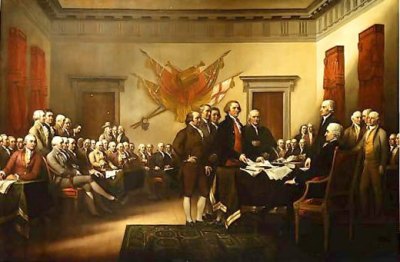The First Continental Congress met in Philadelphia from early September to late October 1774. The Second Continental Congress convened in May of 1775. Richard Henry Lee presented a resolution of independence on June 7, 1776, and the Congress convened a committee on June 11 to draft a declaration of such. Thomas Jefferson from Virginia wrote the first draft.
The Committee of Five presented the final draft of the declaration to the full Congress on June 28. The Lee resolution was adopted on July 2, and the Congress, after some debate and changes, adopted the Declaration of Independence itself on July 4, 1776.
A copy of the Declaration, signed by both the president and the secretary of the Congress, was sent to a local printer, John Dunlap, who made up some couple hundred copies. The signed original is no longer extant, and only twenty-five of the Dunlap broadsides are known to still exist.
The Congress ordered on July 19 that a copy be engrossed and signed by the whole Congress, and most of the delegates signed that copy on August 2. Some delegates never signed, while other newer delegates not present at its adoption were later allowed to sign. It is this signed copy that is on display at the National Archives.
That signed copy is much faded and difficult to read, possibly due in large part to a wet transfer method employed by William Stone, commissioned by President John Quincy Adams to make an engraved copy of the Declaration. It is copies of Stone’s engraving that are most familiar to us today.
The painting pictured above is John Trumbull’s oil on canvas The Declaration of Independence, from 1817 or so, which hangs in the Capitol rotunda. It is variously described as either the presentation of the draft by the Committee of Five or the signing of the Declaration itself. It’s what’s on the back of the two-dollar bill.

I remember reading somewhere that the Declaration that is now kept under glass was damaged by light in the 19th century, when it was kept out for viewing in the old Patent Building or something. Is that the same building where Lincoln’s second Inaugural Ball was held, and the home of my fave D.C. museum, the National Portrait Gallery?